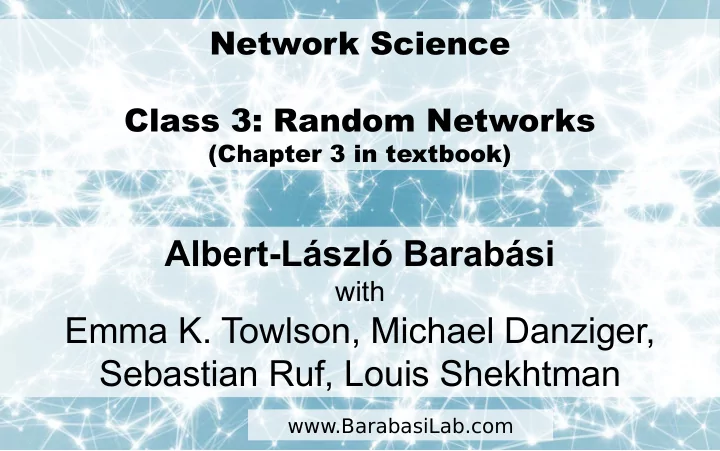

Network Science Class 3: Random Networks (Chapter 3 in textbook) Albert-László Barabási with Emma K. Towlson, Michael Danziger, Sebastian Ruf, Louis Shekhtman www.BarabasiLab.com
Section 7 Real networks are supercritical
Section 7
Section 3.8 Small worlds
SIX DEGREES small worlds Sarah Ralph Jane Peter Frigyes Karinthy, 1929 Stanley Milgram, 1967
SIX DEGREES 1929: Frigyes Kartinthy 1929: Minden másképpen van (Everything is Different) Láncszemek (Chains) “Look, Selma Lagerlöf just won the Nobel Prize for Literature, thus she is bound to know King Gustav of Sweden, after all he is the one who handed her the Prize, as required by tradition. King Gustav, to be sure, is a passionate tennis player, who always participates in international tournaments. He is known to have played Mr. Kehrling, whom he must therefore know for sure, and as it happens I myself know Mr. Kehrling quite well.” "The worker knows the manager in the shop, who knows Ford; Ford is on friendly terms with the general director of Hearst Publications, who last year became good friends with Arpad Pasztor, someone I not only know, but to the best of my knowledge a good friend of mine. So I could easily ask him to send a telegram via the general director telling Ford that he should talk to the manager and have the worker in the shop quickly hammer together a car for me, as I happen to need one." Frigyes Karinthy (1887-1938) Network Science: Random Graphs Hungarian Writer
SIX DEGREES 1967: Stanley Milgram HOW TO TAKE PART IN THIS STUDY 1. ADD YOUR NAME TO THE ROSTER AT THE BOTTOM OF THIS SHEET, so that the next person who receives this letter will know who it came from. 2. DETACH ONE POSTCARD. FILL IT AND RETURN IT TO HARVARD UNIVERSITY. No stamp is needed. The postcard is very important. It allows us to keep track of the progress of the folder as it moves toward the target person. 3. IF YOU KNOW THE TARGET PERSON ON A PERSONAL BASIS, MAIL THIS FOLDER DIRECTLY TO HIM (HER). Do this only if you have previously met the target person and know each other on a first name basis. 4. IF YOU DO NOT KNOW THE TARGET PERSON ON A PERSONAL BASIS, DO NOT TRY TO CONTACT HIM DIRECTLY. INSTEAD, MAIL THIS FOLDER (POST CARDS AND ALL) TO A PERSONAL ACQUAINTANCE WHO IS MORE LIKELY THAN YOU TO KNOW THE TARGET PERSON. You may send the folder to a friend, relative or acquaintance, but it must be someone you know on a first name basis. Network Science: Random Graphs
SIX DEGREES 1967: Stanley Milgram Network Science: Random Graphs
SIX DEGREES 1991: John Guare "Everybody on this planet is separated by only six other people. Six degrees of separation. Between us and everybody else on this planet. The president of the United States. A gondolier in Venice…. It's not just the big names. It's anyone. A native in a rain forest. A Tierra del Fuegan. An Eskimo. I am bound to everyone on this planet by a trail of six people. It's a profound thought. How every person is a new door, opening up into other worlds." Network Science: Random Graphs
WWW: 19 DEGREES OF SEPARATION Image by Matthew Hurst Blogosphere Network Science: Random Graphs
DISTANCES IN RANDOM GRAPHS Random graphs tend to have a tree-like topology with almost constant node degrees. d max + 1 − 1 d max = log N d max = ⟨ k ⟩ 2 + ... + ⟨ k ⟩ d max N = 1 + ⟨ k ⟩ + ⟨ k ⟩ » ⟨ k ⟩ log ⟨ k ⟩ ⟨ k ⟩ − 1 Network Science: Random Graphs
DISTANCES IN RANDOM GRAPHS d max = log N log ⟨ k ⟩ In most networks this offers a better approximation to the average distance between two randomly chosen nodes, d , than to d max . ⟨ ⟩ < d >= log N log ⟨ k ⟩ We will call the small world phenomena the property that the average path length or the diameter depends logarithmically on the system size. Hence, ”small” means that d is proportional to log N, rather than N. ⟨ ⟩ The 1/log k term implies that denser the network, the smaller will be the ⟨ ⟩ distance between the nodes. Network Science: Random Graphs
DISTANCES IN RANDOM GRAPHS compare with real data Network N L ‹k› ‹d› dmax lnN/ln‹k› Internet 192244 609066 6.34 6.98 26 6.58 WWW 325729 1497134 4.6 11.27 93 8.31 Power Grid 4941 6594 2.67 18.99 46 8.66 Mobile-Phone Calls 36595 91826 2.51 11.72 39 11.42 Email 57194 103731 1.81 5.88 18 18.4 Science Collaboration 23133 93437 8.08 5.35 15 4.81 Actor Network 702388 29397908 83.71 3.91 14 3.04 Citation Network 449673 4707958 10.43 11.21 42 5.55 E. Coli Metabolism 1039 5802 5.58 2.98 8 4.04 Protein Interactions 2018 2930 2.9 5.61 14 7.14 Given the huge differences in scope, size, and average degree, the agreement is excellent.
Why are small worlds surprising? Suprising compared to what? Network Science: Random Graphs
Three, Four or Six Degrees? For the globe’s social networks: ⟨ k 10 3 ⟩ ≃ N 7 × 10 9 for the world’s population. ≃ d >=ln ( N ) ln ⟨ k ⟩ = 3.28
Image by Matthew Hurst Blogosphere
Recommend
More recommend